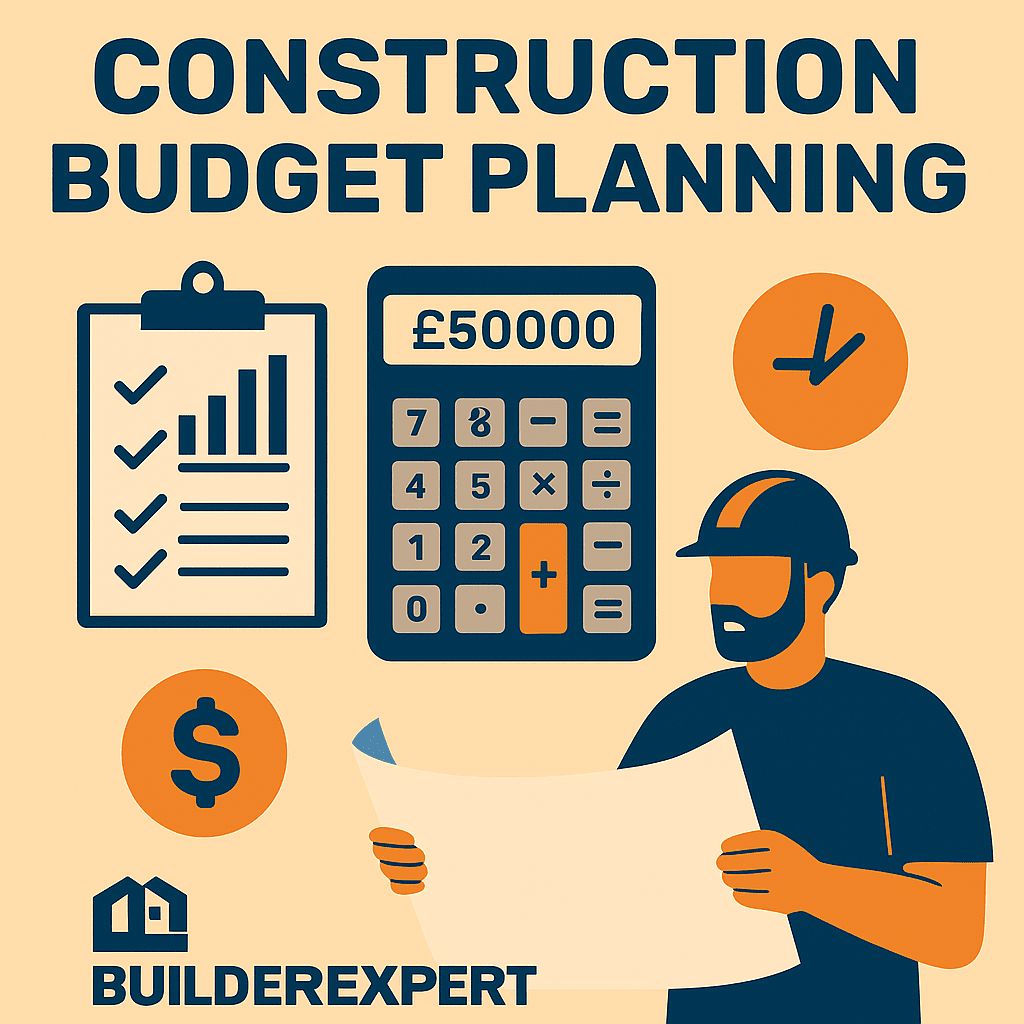In the UK construction industry, getting the numbers right from the start can mean the difference between a profitable project and one that drains your resources. Construction budget planning isn’t just about adding up costs — it’s about anticipating challenges, managing risk, and keeping every pound accounted for from the first design sketch to the final handover.
Without a clear budget plan, even the most well-managed site can spiral into overspending. Material prices fluctuate, labour availability changes, and unexpected site conditions can all throw a project off course. That’s why the most successful builders combine accurate estimates, real-time cost tracking, and flexible contingency allowances to stay in control.

Using tools like the Detailed Construction Estimate and Real-Time Construction Estimating Software from BuilderExpert ensures that every line item is backed by data — giving you the confidence to quote accurately, win more jobs, and protect your profits.
In this guide, we’ll explore how to approach construction budget planning step-by-step, common mistakes to avoid, and strategies to help you keep projects on track without cutting corners.
1. The Core Elements of a Solid Construction Budget Plan
Effective construction budget planning starts with knowing exactly what needs to be included in your cost breakdown. Skipping even one major category can leave you exposed to unexpected expenses that eat into your profit.
Labour Costs
Labour is often one of the largest expenses in any build. Include not only wages for your direct team but also subcontractor fees, overtime, and any specialist trades required. Overlooking these can quickly derail your budget.
Materials and Equipment
From bricks to scaffolding hire, every material and piece of equipment must be accounted for. Prices can change rapidly, so work with suppliers you trust and get updated quotes regularly.
Overheads
Your construction budget planning should also include indirect costs like insurance, permits, utilities, and administrative expenses. These are easy to overlook but can add up significantly over the course of a project.
Contingency Fund
Even with the best planning, unexpected issues can arise — from supply chain delays to discovering structural problems mid-build. A contingency fund (usually 5–10% of the total budget) helps you deal with these surprises without jeopardising the project.
Clear Scope Definition
A well-defined scope of work helps avoid “scope creep,” where additional tasks are added without proper budgeting. Referencing resources like the Construction Estimate Example can ensure your scope is documented clearly and priced accurately from the start.
2. Steps to Create an Accurate Construction Budget
A good construction budget planning process is structured, methodical, and based on reliable data — not guesswork. By following these steps, you can create a budget that’s both realistic and resilient to changes.
Step 1: Gather All Project Information
Start by collecting detailed drawings, specifications, and timelines. The more accurate your initial information, the less room there is for budget surprises later.
Step 2: Break Down the Project into Phases
Divide your build into clear phases — design, groundworks, structure, finishing — and assign costs to each. This makes tracking spending much easier throughout the project.
Step 3: Use Professional Estimating Tools
Manual calculations leave room for error. Instead, use software like Bill of Quantity in Construction Estimating to ensure that every material, labour hour, and subcontractor cost is captured in detail.
Step 4: Get Multiple Supplier and Subcontractor Quotes
Relying on a single quote is risky. Gathering multiple prices not only gives you a better deal but also strengthens your negotiating position.
Step 5: Include a Contingency and Review Regularly
Set aside 5–10% of the total budget for unexpected costs. Review your budget weekly or monthly to adjust for any changes in pricing or project scope.
Pro Tip: Link your budget to real-time cost tracking tools so you can see instantly when you’re approaching or exceeding a category limit.
3. Common Mistakes in Construction Budget Planning
Even experienced builders can fall into traps that derail their construction budget planning. Recognising these mistakes early can save time, money, and client trust.
Underestimating Labour and Material Costs
Many budgets fail because they’re based on outdated prices or overly optimistic timelines. Always use current market rates and build in allowances for seasonal fluctuations.
Ignoring Indirect Costs
It’s easy to focus only on direct expenses like bricks and wages, but failing to include overheads such as insurance, permits, and administrative work can leave you short.
Not Reviewing the Budget Regularly
A budget is a living document, not a one-time calculation. Without regular reviews, small overruns can snowball into significant losses before you notice.
Skipping the Contingency Fund
Some builders skip the contingency fund to present a lower estimate to the client. This short-term tactic almost always backfires when inevitable surprises occur.
Poor Scope Definition
If the scope isn’t clearly documented and agreed upon, you risk “scope creep,” where new tasks get added without adjusting the budget. Resources like the Detailed Construction Estimate help avoid this problem by locking in all agreed items from the start.
Avoiding these pitfalls is key to maintaining profitability and delivering projects on time.
4. How to Use Construction Budget Planning to Improve Profit Margins
Construction budget planning isn’t just about preventing losses — it’s also a powerful tool for boosting profitability. When you have a clear, accurate budget, you can identify opportunities to increase efficiency, cut waste, and negotiate better deals.
Identifying Cost-Saving Opportunities
A detailed budget allows you to spot areas where alternative materials, suppliers, or methods could save money without sacrificing quality. This might mean bulk-ordering materials, scheduling trades more efficiently, or choosing products with better durability.
Linking Budgets to Profit Tracking
By integrating your budget with tools like Profit Per Version, you can see exactly how each change in scope or cost affects your bottom line. This insight lets you adjust in real-time to protect profit margins.
Improving Negotiation Power with Data
Clients are more likely to accept a fair price when you can show them a breakdown of costs backed by reliable data. Detailed, transparent budget reports strengthen your position in negotiations and help avoid disputes later.
Reducing Waste and Downtime
A well-planned budget, combined with accurate scheduling, ensures that labour and materials arrive when needed — reducing idle time and costly delays.
When used effectively, construction budget planning becomes more than just a cost-control measure — it’s a profit-growth strategy.
5. The Role of Technology in Modern Construction Budget Planning
In today’s competitive market, construction budget planning is no longer just a spreadsheet exercise — it’s a tech-driven process that connects estimating, scheduling, and real-time tracking. Builders who embrace modern tools can make faster decisions, spot risks earlier, and deliver projects more efficiently.
Real-Time Pricing Integration
With Real-Time Construction Estimating Software, material and labour prices update instantly, ensuring your budget always reflects current market rates. This prevents underquoting and protects your profit margins.
Digital Collaboration
Cloud-based platforms allow builders, subcontractors, and clients to work from the same data. Everyone sees updated budgets, schedules, and scope changes instantly — reducing the risk of costly miscommunication.
Bill of Quantity Automation
Using Bill of Quantity in Construction Estimating ensures every cost is itemised, making it easier to track where money is being spent and where savings can be found.
Mobile Access
Being able to update budgets and forecasts directly from the site means you can respond to changes without delays, keeping the project moving and finances in check.
Technology transforms construction budget planning from a static document into a dynamic, interactive process that keeps your project financially healthy.
6. Best Practices for Construction Budget Planning
To make the most of construction budget planning, you need more than just accurate numbers — you need habits and processes that keep those numbers under control throughout the project.
Finalise the Scope Before Starting
Lock in the scope of work before the first shovel hits the ground. Any changes should go through a formal variation process to ensure they’re budgeted for properly.
Review and Update Regularly
Set a schedule for reviewing the budget — weekly for larger builds, monthly for smaller ones. This keeps your plan aligned with reality and helps catch overruns early.
Track Costs by Category
Break down spending into categories like labour, materials, plant hire, and overheads. This makes it easier to identify where costs are creeping up.
Communicate Clearly with Clients
Transparent reporting builds trust. Use tools like the Construction Estimate Example to present professional, easy-to-read breakdowns that clients can understand.
Include a Contingency — and Protect It
Your contingency fund should only be used for genuine unforeseen costs. Guard it carefully to ensure you have resources available if something unexpected happens.
Learn from Past Projects
Analyse budgets from completed projects to see where your estimates were accurate and where they fell short. This makes your future construction budget planning even more precise.
Following these best practices ensures your budget stays accurate, your profits stay protected, and your clients stay confident in your process.
Conclusion: Making Construction Budget Planning Work for You
Construction budget planning is one of the most powerful tools a builder can use to deliver projects on time, on budget, and with healthy profit margins. By breaking the process into clear steps, avoiding common mistakes, leveraging technology, and following proven best practices, you can transform budgeting from a reactive task into a proactive strategy.
A strong budget protects you from cost overruns, gives you confidence when negotiating with clients, and ensures every decision is backed by accurate data. Whether you’re managing a small renovation or a multi-million-pound commercial build, disciplined construction budget planning will set you apart from competitors and safeguard your reputation.
Stay Connected with BuilderExpert
For more tips, tools, and resources to improve your building projects, connect with BuilderExpert on social media:
- Facebook – Join our community of builders and homeowners.
- LinkedIn – Connect with industry professionals.

